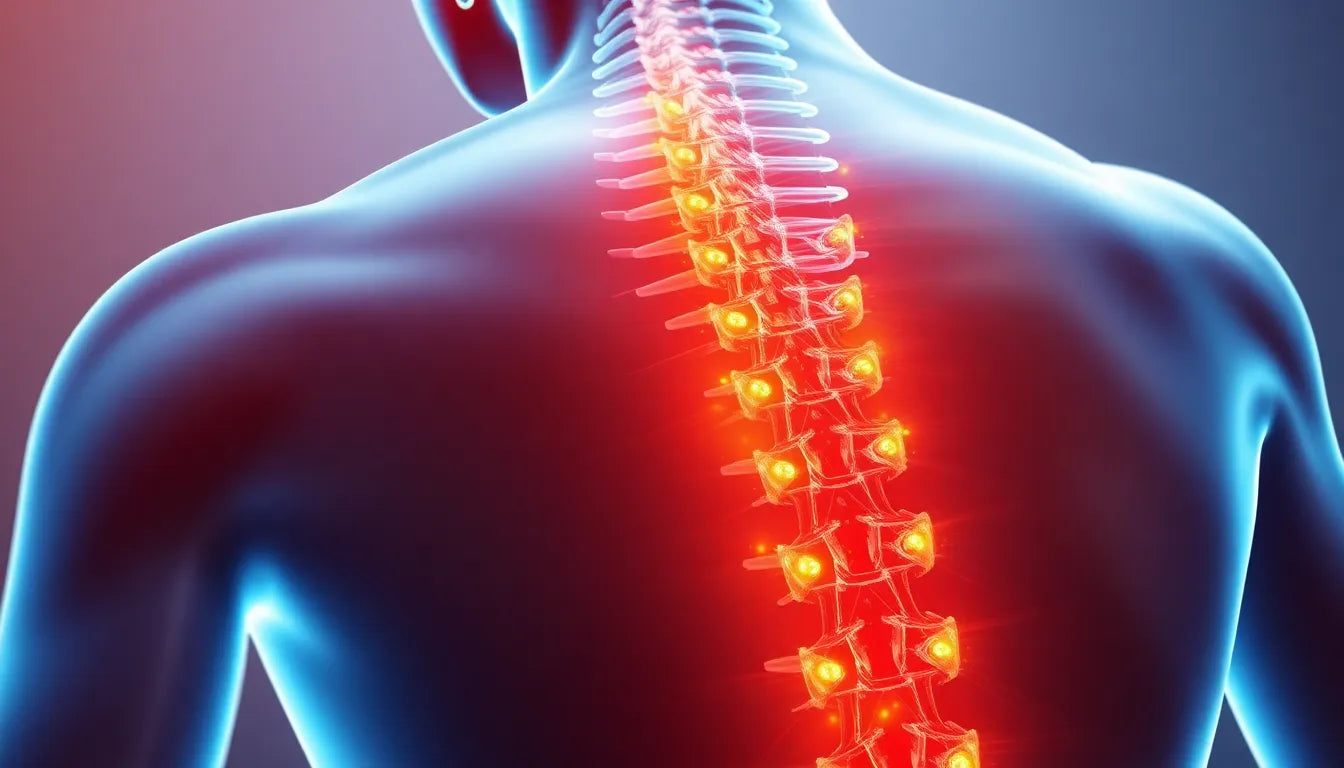In the realm of spinal health, herniated discs are a common concern, affecting a significant portion of the population. These discs, which act as cushions between the vertebrae, can sometimes slip out of place or rupture, leading to discomfort and pain. This raises a critical question: can a herniated disc heal on its own? Understanding the natural healing process is essential, not only for managing symptoms but also for making informed decisions about treatment options.
understanding herniated discs
A herniated disc occurs when the soft inner gel of the disc pushes through a tear in the tougher exterior. This can result in nerve irritation, leading to symptoms such as back pain, leg pain, numbness, or weakness. The condition is often seen in the lower back (lumbar spine) but can also occur in the neck (cervical spine). For many, the prospect of recovery without surgical intervention is appealing, prompting curiosity about the body's ability to heal naturally.
the significance of natural recovery
The possibility of a herniated disc healing naturally carries substantial implications for one's lifestyle, productivity, and mental health. Natural healing can mean avoiding the risks and costs associated with surgery, such as infection, prolonged recovery times, and financial burdens. Moreover, it allows individuals to maintain a more active lifestyle during recovery, which can contribute positively to overall well-being. Understanding the potential for natural healing empowers individuals to explore conservative treatment options and adopt lifestyle changes that support recovery.
importance of awareness
Awareness of the natural healing potential of herniated discs is crucial. It encourages individuals to be proactive in managing their condition through non-surgical means. This knowledge can lead to better pain management strategies, reduced anxiety about the condition, and a more informed dialogue with healthcare providers. Furthermore, it underscores the importance of monitoring symptoms and seeking medical advice when necessary, ensuring that any serious complications are addressed promptly.
As we delve deeper into the mechanisms and factors influencing the natural healing of herniated discs, it becomes clear that while the body possesses remarkable healing capabilities, each individual's journey is unique. The next sections will explore the biological processes involved in natural recovery and the various factors that can influence this process, providing a comprehensive understanding of how a herniated disc can heal on its own.
understanding natural healing of herniated discs
The human body has remarkable capabilities to heal itself, and this extends to herniated discs. The natural healing process involves several biological mechanisms that work together to alleviate the condition. One of the primary processes is the retraction of the herniated disc material. Over time, the body can gradually pull back the protruding disc material, reducing pressure on the affected nerves. This retraction can significantly alleviate symptoms and contribute to recovery.
Another crucial mechanism is the dehydration and shrinkage of the herniated disc. As the disc loses water content, it becomes smaller, which can help reduce the pressure on surrounding nerves. This process is a natural response of the body and plays a vital role in the spontaneous healing of herniated discs. Additionally, the body's inflammatory immune response aids in the resorption of the herniated material. The immune system sends cells to break down and absorb the extruded disc fragments, further facilitating recovery.
statistical insights into healing rates
Scientific studies provide encouraging statistics about the natural healing of herniated discs. Research indicates that up to 90% of herniated discs show improvement within six months through natural processes. The likelihood of spontaneous regression varies depending on the type of herniation. For instance, sequestrated discs have a high spontaneous regression rate of 96%, while extruded discs show a 70% regression rate. Protruded discs have a 41% chance of natural improvement, and bulged discs have a 13% chance. These statistics highlight the body's impressive ability to heal itself without surgical intervention in many cases.
factors influencing natural recovery
Several prognostic factors can influence the healing potential of a herniated disc. Age and overall health play significant roles in determining the body's healing capacity. Younger individuals with good overall health tend to have a higher likelihood of natural recovery. The severity and location of the herniation also impact the healing process. More severe herniations or those located in areas with limited blood supply may take longer to heal.
Lifestyle factors such as activity level and weight can also affect recovery. Maintaining a healthy weight reduces the strain on the spine, promoting healing. Engaging in low-impact activities and exercises that strengthen the core muscles can support the spine and enhance recovery. These factors emphasize the importance of a holistic approach to healing, where lifestyle modifications complement the body's natural processes.
complementary approaches to support healing
In addition to the body's natural healing mechanisms, several complementary approaches can support recovery from a herniated disc. Natural supplements such as collagen, omega-3 fatty acids, MSM, glucosamine, and curcumin may aid in disc healing by reducing inflammation and promoting tissue repair. These supplements can be valuable additions to a recovery plan, but it's essential to consult with a healthcare provider before starting any new regimen.
Lifestyle modifications can also play a crucial role in recovery. Weight management through a balanced diet and regular exercise can alleviate pressure on the spine and enhance healing. Stress reduction techniques, such as mindfulness and meditation, can help manage pain and improve overall well-being. Non-medicinal therapies like acupuncture, inversion therapy, and far infrared heat can provide additional relief and support the body's healing processes.
In summary, the natural healing of herniated discs is a complex process influenced by biological mechanisms, individual factors, and lifestyle choices. Understanding these aspects empowers individuals to take proactive steps towards recovery, potentially avoiding surgery and its associated risks. By embracing a holistic approach that combines natural healing with complementary therapies, individuals can support their body's remarkable ability to heal itself.
Knowing when to seek medical intervention
While many individuals experience significant improvement in their herniated disc symptoms through natural healing processes, there are critical warning signs that necessitate immediate medical evaluation. Persistent or worsening pain that does not respond to conservative treatments is a key indicator. Additionally, the onset of neurological symptoms such as numbness, tingling, or weakness in the limbs should not be ignored. These symptoms could suggest nerve compression that requires timely intervention.
One of the most serious signs is the loss of bladder or bowel control, which may indicate a condition known as cauda equina syndrome. This is a medical emergency that demands urgent attention to prevent permanent damage. Monitoring these symptoms closely and seeking professional advice when necessary ensures that any potential complications are addressed promptly, safeguarding long-term health and mobility.
Understanding the recovery timeline
The timeline for recovery from a herniated disc can vary significantly among individuals, influenced by factors such as age, overall health, and the severity of the herniation. On average, most cases see notable improvement within six months, with many individuals experiencing relief from symptoms much sooner. However, it is important to recognize that recovery is a highly individual process.
Some people may notice gradual improvements over weeks, while others might take longer to experience significant changes. Maintaining realistic expectations and adhering to a balanced approach that combines natural healing methods with professional medical advice can help individuals navigate their recovery journey effectively. Regular follow-ups with healthcare providers can also provide valuable insights into the progression of healing and necessary adjustments to treatment plans.
Conclusion: Embracing a balanced approach
The potential for a herniated disc to heal naturally offers hope for many individuals seeking to avoid surgical intervention. By understanding the body's natural healing mechanisms and being aware of the factors that influence recovery, individuals can take proactive steps towards managing their condition. Embracing a holistic approach that combines natural methods, lifestyle modifications, and medical guidance when necessary ensures a comprehensive path to recovery.
Monitoring symptoms closely and maintaining open communication with healthcare providers is crucial in determining the most appropriate course of action. Whether through natural healing or medical intervention, the goal is to achieve optimal health and well-being, allowing individuals to return to their daily activities with confidence and comfort.
Frequently Asked Questions
How long does it take for a herniated disc to heal naturally?
Most cases of herniated discs show improvement within six months through natural processes, although individual recovery times can vary based on health and severity of the condition.
What percentage of herniated discs heal without surgery?
Approximately 66.66% of herniated discs experience spontaneous resorption, allowing many individuals to avoid surgical intervention.
Are there any exercises that can help with herniated disc recovery?
Gentle stretching and strengthening exercises can support recovery, but it is essential to perform these under medical guidance to ensure they are safe and effective.
Can lifestyle changes impact the healing process?
Yes, lifestyle changes such as weight management and stress reduction can significantly influence the recovery process by reducing strain on the spine and promoting overall health.
What are the signs that I should seek medical intervention?
Seek medical help if you experience severe or worsening pain, neurological symptoms like numbness or weakness, or loss of bladder or bowel control, as these may indicate serious complications.
Sources
- Chiu, C.C., et al. (2015). "The probability of spontaneous regression of lumbar herniated disc: a systematic review." Clinical Rehabilitation.
- Spine-Health. (n.d.). "Healing a Herniated Disc."
- Mayo Clinic. (2021). "Herniated disk - Symptoms and causes."
- Komori, H., et al. (1996). "Magnetic resonance imaging of lumbar disc herniation as a predictor of surgical outcome." Spine.
- Jensen, M.C., et al. (2011). "Magnetic resonance imaging of the lumbar spine in people without back pain." The American Journal of Sports Medicine.


















